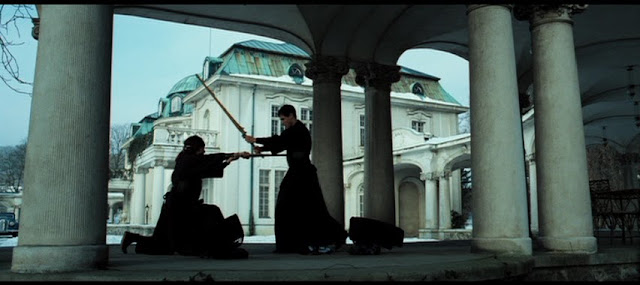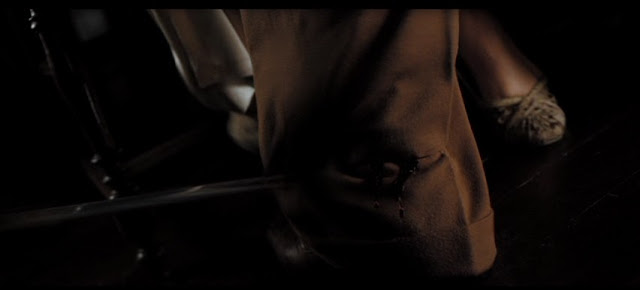The other Hannibal Lecter movies that have been analyzed on this blog (Manhunter, The Silence of the Lambs, and Hannibal) have all been found to contain 'hidden plots', that is, there are things going on beneath the surface of these movies, that the audience does not see. This is also true of Hannibal Rising, and its hidden plot is discussed in the below.

Near the beginning of the film, while Grutas and his men were in the Lecter family's hunting lodge (above left), one of them discovered Hannibal's identity from a scrapbook that was there (above right). After the cannibalization of Mischa, and Hannibal's subsequent escape from the hunting lodge (and then later, the orphanage), he arrived at Murasaki's residence (below left). While he was there, Murasaki found out what happened at the lodge, by overhearing Hannibal talking about the incident in his sleep (below right), and she decided that she would enable Hannibal to get revenge on Grutas and his men.


Murasaki began to carry out her plan by training Hannibal to be what one could describe as a warrior (above left). She then set up things so that Hannibal killed a butcher, to cap off his training: Lady M. went with Hannibal to the market where the butcher worked, knowing that the butcher would insult her, as he had done in the past (as indicated by the fact that he knew she was Japanese). One clue that Murasaki pre-planned for Hannibal to confront the butcher, was that during the scuffle in the market, she turned out to be carrying a knife (above right), which she used to keep another man at bay while Hannibal and the butcher were fighting (below left). Later, Hannibal went looking for the butcher, found him near a lake, fought him (below right), and then beheaded him with a sword.

Not long after Hannibal killed the butcher, inspector Popil made his first visit to Murasaki's residence (as shown at left), to investigate the butcher's death.

Murasaki later provided Hannibal with an alibi for the butcher's killing - recall the butcher's severed head being discovered gored on a post (above left), in a scenario such that it could not possibly have been placed by Hannibal (which, in fact, it was not - it was instead placed by Murasaki). The intended next step was for Hannibal to go after Grutas and his men. Hannibal returned to the ruins of the hunting lodge, and found their dog tags (above right).
Later, when the inspector made what appeared (to the Hannibal Rising audience) to be only his second visit to Murasaki (as shown at left), he said on arriving, "This isn't a social call." This was ostensibly only his way of indicating that he had come over to discuss serious matters (which he had). However, another implication of his statement was that there had been additional visits since Popil and Murasaki's first meeting (these visits having been hidden from the film's audience), which were social in nature. The point is that for some time prior to this supposed second visit, Murasaki and the inspector had been having a sexual relationship. Evidence that Lady M. knew more about Popil than it seemed she could have, based only on the first meeting between the two, includes there being certain things she said to Popil during this (again, supposed) second visit, which indicated that she already knew he had lost family during the war. The implication is that he must have told her this during one of his intervening 'social calls'. At some point while the two were together, prior to this 'second' meeting, Murasaki let Popil know what Grutas and his men had done at the Lecter hunting lodge. Eventually, Popil convinced her to let him bring Grutas and his men to justice, rather than let Hannibal kill them.
The plan established between Popil and Murasaki included her being a spy in Grutas's camp. She developed a sexual relationship with Grutas, with the idea having been to get information out of him which could later be used to convict him as a war criminal. Later, Grutas kidnapped her (see screencap at left), with his idea having been that he could draw Hannibal into a trap.

In the sequence of scenes on Grutas's houseboat at the film's end, it appeared Lady M. was in impending danger of being killed by Grutas. While Hannibal, who had been able to board the houseboat, was walking along a passageway approaching Grutas's cabin (above left), Grutas went inside an adjoining area (above right) so that Hannibal would not see him. Then, as soon as Hannibal entered Grutas's cabin, Grutas appeared from behind him and fired a single gunshot (below left), which appeared to strike Hannibal in his back; but, Hannibal was protected from the bullet by a weapon (a tanto, which is a kind of short sword), that he had hidden underneath his jacket (the tanto with a bullet hole in it is shown at below right).


Following the above, Hannibal turned the tables on Grutas, physically incapacitating him by slicing his Achilles tendons (above left). Murasaki's hands had been only tied loosely behind her back (above right). Lecter himself didn't notice this until after he had disabled Grutas, and by then, he was set on killing him; so he wasn't particularly worried at this point about whether Mursaki was trying to deceive him in some way.
In the above-described final showdown between Hannibal and Grutas, the culmination of which is shown at left (with Hannibal on top of Grutas, whom he then kills), Lady M. needed to have Hannibal win the confrontation, and quickly; for if inspector Popil arrived before or during the confrontation between the two men, and arrested Grutas, then later, the press and/or some other party might have found out about the aforementioned sexual relationship between Murasaki and Grutas, and that Murasaki and Popil had been working together, and had themselves been having a sexual relationship. Popil would have been called out for using unethical methods to apprehend Grutas. Note that by the time of the confrontation between Grutas and Hannibal, Grutas was the last member of his gang still living (besides a man who had escaped to Canada, whom Hannibal kills at the movie's ending).











